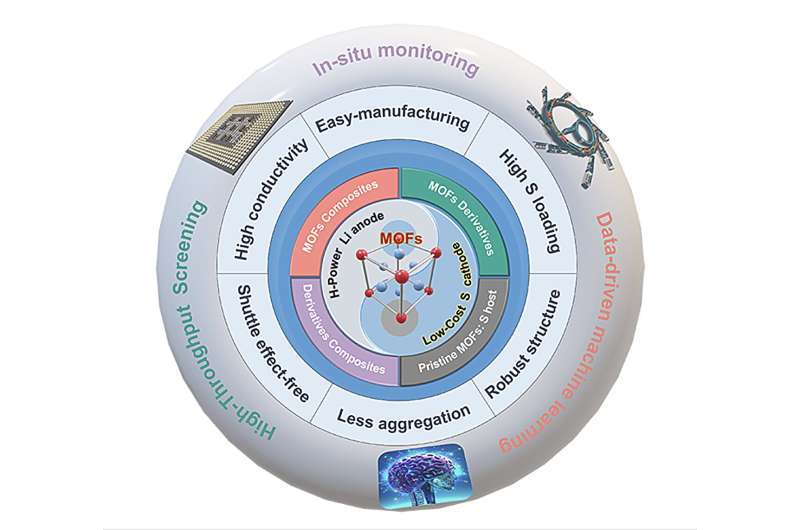This article has been reviewed according to Science X's editorial process and policies. Editors have highlighted the following attributes while ensuring the content's credibility:
fact-checked
peer-reviewed publication
proofread
Improving lithium-sulfur batteries with metal-organic framework-based materials

Current lithium-ion battery technology does not have the energy density necessary to meet the demands for renewable energy. In theory, lithium-sulfur batteries could be a viable alternative with a higher specific capacity and energy density. However, sulfur has disadvantages that currently limit its practical adoption.
A comprehensive review published in Nano Research outlines how metal-organic framework-based cathode materials could improve the performance of lithium-sulfur batteries, making them a practical alternative to lithium-ion batteries.
"The application of high-performance lithium-sulfur batteries is still impeded by some major issues, leading to unacceptable practical capacity and cycling stability," said Weihua Chen, a researcher at Zhengzhou University.
"First, sulfur's poor electrical conductivity and those of the discharging products significantly increase some internal resistance of the batteries, limiting the utilization efficiency of the active materials. Also, severe volumetric expansion of sulfur cathodes after the lithiation process causes the structural pulverization of electrodes."
With these limitations, lithium-sulfur batteries present safety issues, as well as performance issues, that currently prevent their wide adoption.
Advanced sulfur cathodes made out of metal-organic frameworks could be the solution. Metal-organic frameworks are typically made up of a metal ion/cluster and have unique properties such as high porosity, adjustable pore size, and controllable pore structure.
Pristine metal-organic frameworks have not yet been adopted into lithium-sulfur batteries because of poor electrical conductivity and insufficient structural stability; however, recent studies have shown how metal-organic frameworks can be combined with conductive material, such as graphene, carbon nanotube, and some polymers.
"Because of the porous microstructure, ultra-large accessible specific surface area, and adjustable function group, metal-organic framework-based materials have received the attention of investigators as potential cathode hosts for lithium-sulfur batteries and have made significant progress. Particularly, metal-organic framework-related materials could effectively restrain the dissolution and diffusion of polysulfide in the electrolytes," said Chen.
This review of published articles looked at pristine metal-organic frameworks, different metal-organic framework composites, and metal-organic framework derivatives. These unaltered inorganic metal and organic components have crystallographic structures and show promise in storing the active sulfur. However, most of them do not have the conductivity necessary for effective battery operation.
Metal-organic framework composites enhance the properties of metal-organic frameworks, improving conductivity and reinforcing structural stability. Graphene, carbon nanotubes, and conductive polymers are all viable options for improving on the limitations of pristine metal-organic frameworks. Another alternative is materials derived from metal-organic frameworks or metal-organic framework derivatives.
For example, metal-organic framework-derived carbon materials can facilitate electron and ion transfers and solve the volume expansion problems found within the sulfur cathodes, but could compromise the structure of the metal-organic framework. Research is ongoing into how these different materials could be improved and best utilized in lithium-sulfur batteries.
Looking ahead, researchers are continuing to explore how metal-organic framework-based materials and their unique features can improve the performance of lithium-sulfur batteries.
"Metal-organic framework-related materials are emerging as promising sulfur cathode materials for lithium-sulfur batteries. Despite significant progress in recent years, there still exist challenges to overcome for the commercialization of lithium-sulfur batteries. It will take time and effort to achieve practical application of metal-organic framework-related materials in lithium-sulfur batteries, but this review could offer useful guidance for the future development of these materials," said Chen.
More information: Zhengkun Xie et al, Metal organic frameworks-based cathode materials for advanced Li-S batteries: A comprehensive review, Nano Research (2024). DOI: 10.1007/s12274-024-6481-0
Journal information: Nano Research
Provided by Tsinghua University Press



















